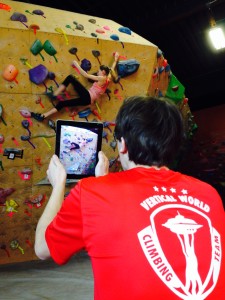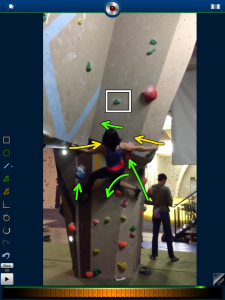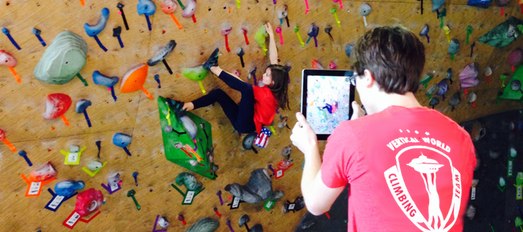
Perhaps no other method for training athletes is more important than letting the climber see what they are doing. A coach’s words have a limited effect when an athlete is pumped with adrenaline. But seeing is believing and video may just be the best way to improve a climber’s performance.
That’s why top coaches around the world are using innovative video analysis apps like Coach’s Eye, Ubersense and CoachMyVideo.
These apps allow a coach or athlete to use a video recording to break down specific movements, inefficiencies, mistakes and successes. But don’t be mistaken, these apps are more than just a video camera. This new generation of recorders allows the user to see side-by-side comparisons, super-slow-motion analysis and on-screen drawing tools.
These apps can be used on various devices but most climbing coaches use a mini-tablet during practice. Filming a drill or performance and then instantly showing that to the climber has never been easier.
Meg Coyne, a coach at Vertical World in Seattle, WA has been using the Coach’s Eye app for the last eight months. “It’s certainly been a useful addition to our quiver of tools. Being able to show a climber what they’re doing rather than tell them has a deeper impact.”
“One thing I use Coach’s eye for is filming our kids on their projects and then sitting down with them to watch the video right when they come down,” Coyne told CBJ. “Watching the mistakes the kids make and challenging them to cut them out on the next go so that they know exactly what to change while it’s all still fresh seems to sink in best. We slow down the footage, pause to point out where a foot should have been, draw where the plum line is and where a flag should have been.”
Coach Robin O’Leary, one of the leading performance coaches operating in the UK, recently wrote about how he uses the Coach’s Eye with his clients.
Coach’s Eye allows you to slow down the footage so much that we can see every slight adjustment before the crux move. The arrows help highlight that although Libby was dropping her knee and pushing to gain the height, the contact with the foot was being lost, meaning that too much weight was transferred onto her hand hence she couldn’t quite hold on enough.

In Mesa Arizona, Focus Climbing Center team Coach Joe Czerwinski has been using the Coach’s Eye since September of last year. As a former competitive climber he understands that most athletes need to see the movement to understand it. “Personally, I am a visual learner, so seeing something versus being told works better for me,” Czerwinski told CBJ.
Czerwinski uses the app with his team to highlight proper form during drills. “We made up a dyno and I had them record what I was doing,” Czerwinski said. “I then recorded each one of the kids. With the app, I can play my clip side-by-side with my athletes as a comparison. This allowed me to not only correct what they were doing, but show them slow-motion of exactly what I wanted them to do.”
Video analysis apps are also helping coaches move away from the standard strength and conditioning aspects of training and into more technique and efficiency. Czerwinski uses the app “during onsight sessions, going over small technical issues where the kids made errors– such as not turning their hips all the way into the wall, or not driving their heels down,” he said.
Using video analysis apps like the Coach’s Eye finally gives climbing coaches that scientific edge they’ve been wanting, while the portability and ease of a tablet computer brings it right to the climbing wall.

Climbing Business Journal is an independent news outlet dedicated to covering the indoor climbing industry. Here you will find the latest coverage of climbing industry news, gym developments, industry best practices, risk management, climbing competitions, youth coaching and routesetting. Have an article idea? CBJ loves to hear from readers like you!







